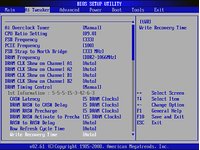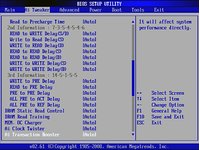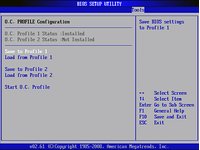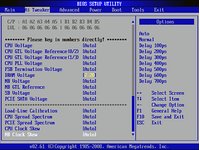11-Way P45 Motherboard Shootout
P5Q Deluxe BIOS And Overclocking
| FSB Frequency | 200 to 800 MHz (1 MHz) |
| Clock Multiplier Adjustment | Yes |
| DRAM Ratios | 1.0, 1.2, 1.25, 1.33, 1.5, 1.60, 1.67, 2.0 |
| PCIe Clock | 100 to 180MHz (1 MHz) |
| CPU Vcore | 0.85 to 2.10 Volts (0.00625 Volts) |
| CPU FSB Voltage | 1.10 to 1.90 Volts (0.02 Volts) |
| Northbridge (MCH) | 1.10 to 2.20 Volts (0.02 Volts) |
| Southbridge (ICH) | 1.50 to 1.80 Volts (0.02 Volts) |
| DRAM Voltage | 1.80 - 3.08 Volts (0.02 Volts) |
| CAS Latency Range | tCAS:3-11 ; tRCD : 3-18 ; tRP : 3-18 ; tRAS : 3-34 |
The P5Q Deluxe has all the important BIOS settings for achieving a top overclock, with a broad enough range of voltages to please the majority of fanatics. A CPU core limit of 2.10 volts for example isn’t as high as that of the Maximus II Formula, but it’s still enough to fry most cores. Asus requires a jumper change to remove a 1.70 volt core limit, and for good reason.


The AI Tweaker menu begins with Asus’ familiar “Ai Overclock Tuner” automatic overclock setting, followed by manual controls for bus speeds, memory ratios and timings.
Several advanced memory timings can also be adjusted, but most users will get the best results by simply choosing “Auto”.
All of the most important voltage levels are adjustable, but unlike the Maximus II Formula, the P5Q Deluxe can only adjust GTL Reference Voltage in pairs.


A complete set of BIOS values can be stored as a user profile, making it easy to restore everything to a previous value should an experimental overclock force a BIOS reset. Profiles can also be exported to a USB flash drive.
Get Tom's Hardware's best news and in-depth reviews, straight to your inbox.
Current page: P5Q Deluxe BIOS And Overclocking
Prev Page P5Q Deluxe Onboard Devices Next Page P5Q Deluxe Software And Accessories-
nickchalk Where are the lower price P45 M/B ?Reply
Asus P5Q pro is out for €110 and P5Q deluxe for €165 the price difference is about 70$ in Greece. -
Proximon I suppose I can get some good from having read this. Did you get paid by the word? Maybe next time you could just put together a complete features chart so that we can have some convenient comparison? You know, so someone could go to a chart and see at a glance which boards had eSATA or firewire, or 8 USB.Reply
-
JPForums I'd rather have the overabundance of information than a lack of information. Presentation could use a little refining (I.E. comparison charts and the likes), but having the relevant information available at least is a good thing.Reply -
the introduction and specifics are nice, the comparision isn't. so, why don't you test with an 8500 or qx9650? 6850 are outdated... and a mobo handling a c2d doesn't mean it can handle a quad too, see P5K for example (it stinks when it comes to a q6600).Reply
-
Crashman procithe introduction and specifics are nice, the comparision isn't. so, why don't you test with an 8500 or qx9650? 6850 are outdated... and a mobo handling a c2d doesn't mean it can handle a quad too, see P5K for example (it stinks when it comes to a q6600).Reply
Tom's Hardware wants the performance of current articles to reflect that of recent articles, so a "standard test platform" was chosen a while ago. It will get updated, but probably not before the new socket becomes widely available. -
zenmaster I would have liked to see something such as a P35 and an X48 as controls to help analyze the P45 Performance.Reply
In otherwords, What is the P45 Gaining me over the older P35.
What would I gain by going to the X48. (Or Lose) -
Crashman zenmasterI would have liked to see something such as a P35 and an X48 as controls to help analyze the P45 Performance.In otherwords, What is the P45 Gaining me over the older P35.What would I gain by going to the X48. (Or Lose)http://www.tomshardware.com/reviews/intel-p45-chipset,1961.htmlReply -
johnbilicki The first 17 pages were filled with nothing but junk from ASUS. Do us a favor: don't even bother featuring or *MENTIONING* anything for any reason from a company that refuses to RMA 200-400 dollar brand new motherboards with anything other then used and usually broken junk. It destroyed my enthusiasm for the article.Reply -
dobby nickchalkWhere are the lower price P45 M/B ?Asus P5Q pro is out for €110 and P5Q deluxe for €165 the price difference is about 70$ in Greece.Reply
the p5q PRo is a p43 board, i should know i have one
